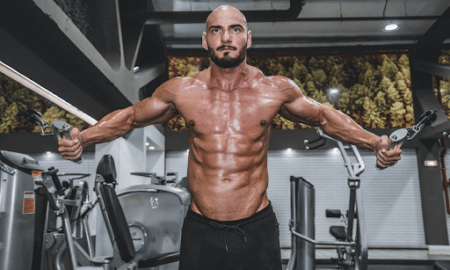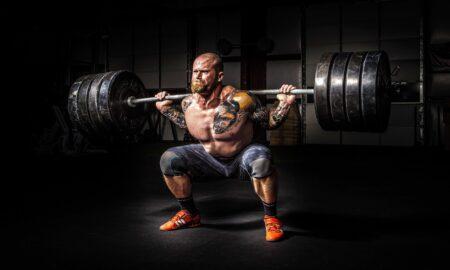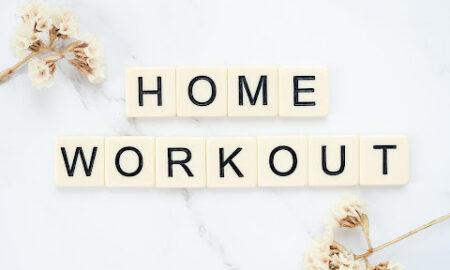Q: I am 26 years old and work as a personal trainer in Bosnia and Herzegovina. I want to begin to train as a natural bodybuilder, but I do not have enough information on how to start. I have trained regularly for eight years, and I have a good foundation—at least I think so. I have never taken banned substances but only supplements: whey protein, creatine and L-glutamine. I hope that you will answer my questions:
1) What type of training program is best to do in the off-season? How much training per week? How many sets per session?
2) How long should the workouts take when training to gain mass in the off-season?
3) How many grams of protein per kilogram of bodyweight are sufficient to increase muscle mass when training in the off-season?
4) How do I calculate how many calories I need when I train for mass? What about when I’m on a diet?
5) Which supplements really work? Creatine? Whey protein? L-glutamine? BCAAs?
6) For muscle definition, what type of training program is best when I am on a diet? How much training per week, and how many sets per session? How long should the sessions be?
7) What’s the best diet for a natural bodybuilder?
8) How many grams of protein per kilogram of bodyweight is sufficient to increase muscle mass when training for muscle definition? What about grams of carbohydrate per kilogram of bodyweight?
I know I am asking a lot. I worked the entire winter to build mass. Now I want to move on to diet, but I don’t know exactly what to do, and my metabolism is such that it’s hard for me to gain weight but easy to lose fat. I hope you will help me. I live in a small country where no one has even heard of natural bodybuilding. Thank you.
A: I would be happy to help you. Congratulations on following the natural bodybuilding lifestyle for the past eight years. You asked some good, basic questions on both off-season training and nutrition as well as the best strategies for getting ripped and lean.
The best training program for the off-season depends on your experience. For someone with your years of training, a more advanced program is called for, one that would have you training your full body over three to four workouts. At this stage you train four or five days per week. I prefer working out only four days per week when training to add mass because I get enough recuperation between workouts to give each training session my best effort.
As for the optimum number of sets per workout, I like keeping my total sets to fewer than 30. An advanced bodybuilder should do approximately three exercises for a big muscle group like chest, back and legs and only two exercises for a smaller bodypart like arms or calves. If you perform three to four sets per exercise, you will be doing six to eight sets for a smaller muscle group and nine to 12 sets for the bigger muscles. Even if you combine several muscle groups in one workout, your total sets should not be more than 25 to 30.
How long each workout lasts depends on the amount of rest you take between sets. If you’re training for mass, you will need to work out with heavy weights for six to eight reps using the basic exercises. In order to give each set 100 percent, you cannot rush the rest periods between sets. I like taking at least three to five minutes when doing heavy, basic exercises such as squats, deadlifts, bench presses, incline presses and barbell rows. You need that rest time to restore the ATP in the muscle cells and give each set your best effort.
I believe in taking in 1.25 grams of protein for each pound of bodyweight. If you weigh 200 pounds—about 90 kilos—you should be eating 250 grams or protein per day. That’s a moderately high amount of protein and should be plenty to restore muscle tissue after a mass-building workout.
With carbohydrate the amount varies depending on your age, metabolism, activity level and body type. If you have a very fast metabolism and have a difficult time adding muscle or bodyweight, I recommend that you eat at least two to three grams of carbohydrates for each pound of bodyweight. If we use the example of the 200-pound bodybuilder, he would be eating 400 to 600 grams of carbohydrates in addition to the 250 to 300 grams of protein.
When I was in my 20s and 30s, I had a very fast metabolism, and it was difficult for me to add muscle. It didn’t matter how heavy I trained or how hard I worked out, if I didn’t eat a lot of calories and carbohydrates, I would not gain weight. I remember one year being stuck at the same weight for eight months, even though I was really trying to bulk up.
At that stage of my career, I had to get 500 to 700 grams of carbohydrate every day to slow my metabolism down and start adding bodyweight. My rule was to eat two sources of complex carbohydrate—oatmeal, whole-wheat bread, baked or sweet potatoes, brown rice or oat bran—with each meal. I was actually getting tired of so much food after months of eating like that.
Now that I’m older and my metabolism is much slower, it would be a mistake to eat that many complex carbs every day. It would add too much bodyfat, and it would be too difficult to get rid of all the excess fat. You have to decide how many calories and carbohydrates you need for gaining size and bodyweight and then do some experimentation. If you’re not adding any size and seem to be at a sticking point, figure out how many calories and carbohydrates you’re taking in and begin increasing them until you start to get bigger.
The most effective supplements, in my opinion, are protein powders, postworkout recovery drinks, creatine, nitric oxide and glutamine. If you’re trying to gain size, you should use a protein supplement that contains carbohydrates and additional calories like Optimum Nutrition Pro Complex Gainer. If you’re looking to stay lean, choose a protein powder that does not include additional carbs.
Creatine is an excellent supplement for strength and power. You can use it both before and after your workout. Nitric oxide supplements are also very effective for getting a great pump during your workouts. I love the new Speed Stack N.O. from American Body Building for energy and a great pump.
Branched-chain amino acids and glutamine are excellent supplements for retaining muscle tissue while dieting to lose bodyfat. They help protect against catabolism when the calories and carbohydrates are low to get that very low bodyfat percentage.
When training for muscle definition, I don’t change my workout program. I still train as heavy as I can with the basic exercises. If you use less resistance and get away from the basic movements that developed your muscle initially, you’ll get smaller as you lose the fat. It’s just common sense—if you stress the muscles less than you did before, they’ll respond by getting smaller.
I rely on my diet for getting leaner and also add some cardio training to speed up the fat loss. Don’t change your weight-training program. Keep training as heavy as possible with the basic exercises, although you may lose a little strength as you eat fewer calories and carbohydrates.
When I’m dieting to lose fat but keep my hard-earned muscle, I increase my protein intake from 1.25 grams per pound of bodyweight to 1.5 grams per pound. You’ll need the extra protein to help maintain your mass as well as increase your metabolism.
To lose the fat, I manipulate my carbohydrate intake. How much you will need to lower your carbs again depends on your metabolism, age, activity level and bodytype. I was able to eat a lot more carbs when I was younger than I can now. If you can get progressively leaner and more ripped by eating a good amount of carb, more power to you. The carb is protein sparing and will help you train heavier and keep more muscle.
If you need to eat less carbohydrate to lose stored bodyfat, it’s best to alternate lower and higher carb intakes. Those who keep their carbs very low all the time seem to lose muscle tissue. If you don’t eat fewer carbs than in the off-season, you’ll have a difficult time losing bodyfat due to higher insulin. The ideal situation is to alternate several days of lower-carb eating with one or two higher-carb days.
How many carbs and calories you’ll need to maintain muscle tissue while losing bodyfat is, again, an individual situation. If you write down everything you eat during the off-season, however, you’ll have a better understanding of your body and how many carbs and calories you should eat in order to lose the fat slowly. You may have to experiment a little to get the macronutrient numbers just right for your body, but you’ll take away most of the mystery in the perfect diet.
The ’10 ABA Natural Illinois
Bodybuilding, Fitness and Figure Championships
I promoted the third annual ABA Natural Illinois Bodybuilding, Fitness and Figure Championships on Saturday, April 10, 2010, at Brooks Middle School in Bolingbrook, Illinois. We had our biggest turnout yet, with 54 talented athletes from the Midwest vying for top honors. The audience was rocking all night, loudly cheering the natural athletes with enthusiasm and energy.
Because it was a natural competition, every bodybuilding and figure athlete was required to take a polygraph test before competing. After the event several other competitors were chosen to take a urinalysis drug test.
Pierce Walker from Rockford, Michigan, won the men’s short class and took the overall title over tall-class winner Larry Montgomery. Forty-one-year-old Pierce displayed full muscle bellies in his upper body and was in excellent condition. He also won his share of bodypart awards, taking home the Best Chest, Best Arms, Best Legs and Most Muscular trophies.
Laurie Ellis showed that determination pays off, finally winning the women’s overall trophy after years of taking second. Laurie was leaner than ever, and she dedicated her victory to her late sister, who recently passed away after a battle with cancer.
Newcomer Maggie Pawalek won the open figure division with her rock-hard abs and lean physique. Maggie just began competing this year after a lifetime of weightlifting. The best is ahead for her.
Caleb Brandholt is another rising star who was making his contest debut in the novice division. A former competitive powerlifter, Caleb, standing 6’1” and 205 shredded pounds, steamrollered the competition with his thick pecs, delts and quads and ripped abs.
The beautiful Shannon Goering won the fitness competition in only her second year of competing. Shannon was pushed hard by Daeneen Merritt, who had an outstanding fitness routine.
Overall Winners
Men’s open: Pierce Walker
Women’s open: Laurie Ellis
Figure open: Maggie Pawalek
Fitness: Shannon Goering
Novice men: Caleb Brandholt
Masters men: Aaron Santos
Masters women: Laurie Ellis
Masters figure: Kelly Schneider
Teen men: Mark Smith
Bikini diva: Staci Boyer
Model search: Heather Nicole Frystak
I want to thank all my sponsors for supporting natural bodybuilding and fitness. They included Optimum Nutrition, American Bodybuilding, Capitol Nutrition, Nutrition Discounters, Pride Nutrition, Chiro One and Govan Fitness.
Editor’s note: John Hansen has won the Mr. Natural Olympia and is a two-time Natural Mr. Universe winner. Check out his Web site at www.NaturalOlympia.com, or send questions or comments to him at [email protected]. Look for John’s DVD, “Natural Bodybuilding Seminar and Competitions,” along with his book, Natural Bodybuilding, and his training DVD, “Real Muscle,” at his Web site or at Home Gym Warehouse, www.Home-Gym.com. Listen to John’s new radio show, “Natural Bodybuilding Radio,” at www.NaturalBodybuildingRadio.com. You can also write to him at P.O. Box 3003, Darien, IL 60561. IM




















You must be logged in to post a comment Login